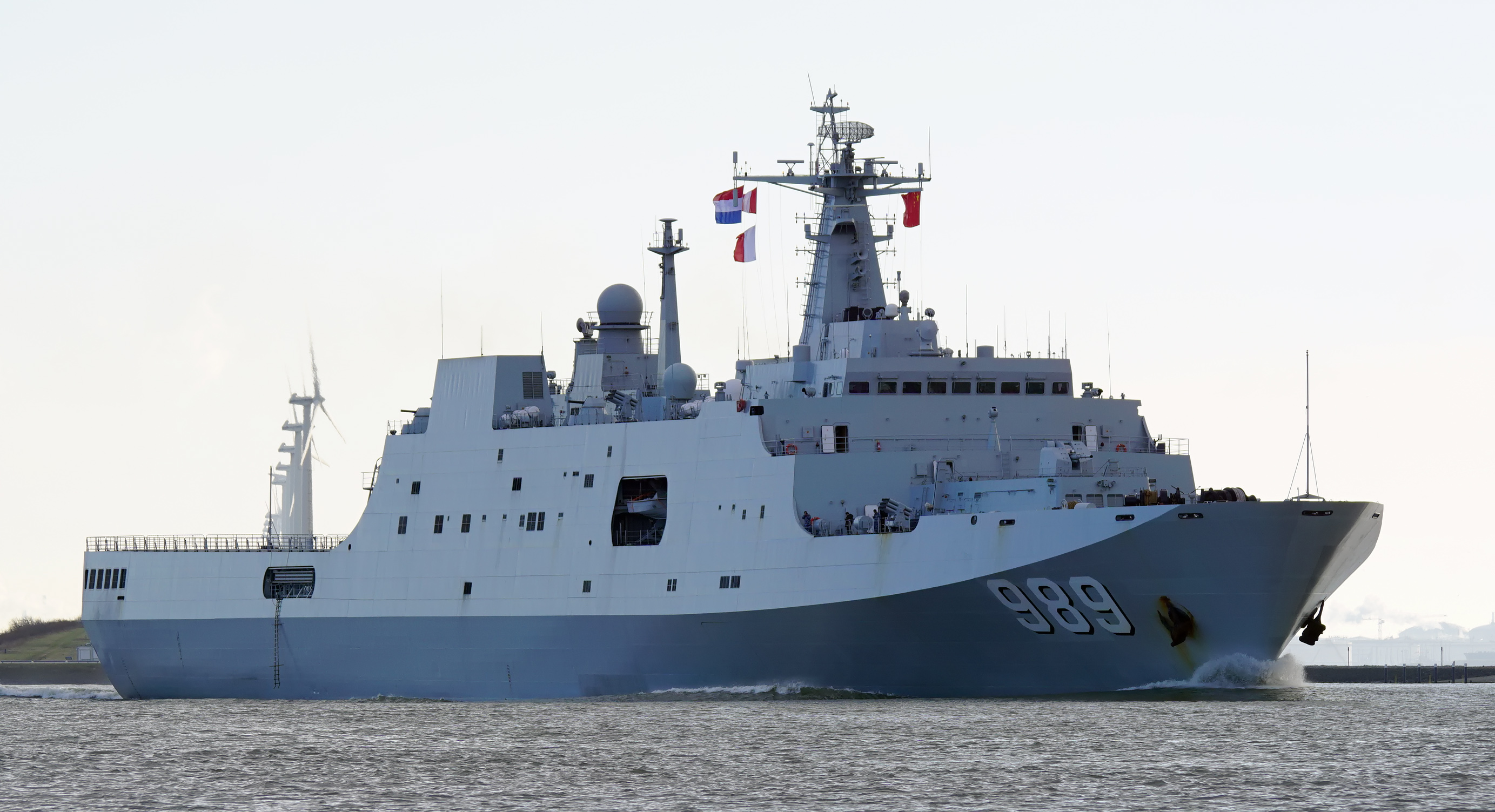China appears to have installed a laser directed energy weapon on one of its Type 071 amphibious assault ships, mirroring U.S. and other nations’ expanding activities in the same arena. Recent actions against Houthi drones in the Red Sea have helped to spur further interest in fitting warships with directed energy weapons of various types, although most of China’s activities with laser weapons have, so far, been conducted on land.
A photo that recently appeared on social media shows an apparently newly installed laser weapon on a People’s Liberation Army Navy (PLAN) Type 071 amphibious transport dock, the vessel having reportedly just emerged from a refit. The system is mounted immediately aft of the 76mm dual-purpose gun on the ship’s bow. When not in use, the weapon is concealed under a relatively large dome-like cover.
You can check out images of the laser system on the Type 071 in the tweet below:
The precise vessel cannot be confirmed at present, although there are claims — including in the tweet above — that it is the Siming Shan, which has the hull number 986. Based on the available censored image, the only other candidate would seem to be hull number 988, the Yimeng Shan.
Until the arrival of the Type 075 landing helicopter dock, the Type 071 was the PLAN’s largest operational amphibious warfare ship. The Type 071, which displaces around 25,000 tons, includes a small flight deck at the stern and hangar space for up to four Z-8 heavy transport helicopters. It also has capacity for four air-cushion landing craft, up to around 60 armored fighting vehicles, and as many as 800 troops. It is loosely comparable to the U.S. San Antonio (LPD-17) class.
Regardless, according to reports, this example of the Type 071 has been selected as a test platform for the laser weapon, which may then make its way onto other warships, too.

That would seem to follow fairly closely the U.S. Navy’s trials of a laser directed energy weapon aboard the very similar (it’s even mounted in generally the same area) San Antonio class landing platform dock USS Portland, which was first spotted with the system installed in late 2019, before successfully knocking down a small drone target in May 2020, as you can read about here.
The laser weapon on USS Portland is formally known as the Laser Weapon System Demonstrator (LWSD) Mk 2 Mod 0 and was developed by Northrop Grumman.

While the status and the capabilities of the Chinese system are unknown, it’s worth noting that the 150-kilowatt class LWSD Mk 2 Mod 0 was primarily developed to provide ships with an additional line of defense against unmanned aircraft and small boat swarms. Additionally, the U.S. laser can be used as a dazzler for blinding optical sensors and seekers. Being equipped with integrated full-motion video cameras, for tracking and aiming, the LWSD Mk 2 Mod 0 can also be used to conduct surveillance. A similar set of capabilities is entirely conceivable for the Chinese system, too.
While there’s an obvious parallel between the Chinese system and the LWSD Mk 2 Mod 0, since both have been installed on amphibious assault ships for testing, there are a number of other laser directed energy weapon programs in the U.S. Navy alone.
An Arleigh Burke class destroyer, the USS Preble is now armed with a High-Energy Laser with Integrated Optical Dazzler and Surveillance system, or HELIOS. This is a 60-kilowatt class directed energy laser weapon and is the first of its kind to be integrated with the Aegis combat system.

Like the LWSD Mk 2 Mod 0, HELIOS is a multi-purpose system. It can put out enough energy to damage or destroy targets including smaller drones and boats and can also be used as a dazzler to blind or confuse optical sensors on enemy ships, drones and aircraft, as well as optical seekers on incoming missiles and other munitions. It, too, has a secondary surveillance role using its own optical sensors.
Then there is the AN/SEQ-3 Laser Weapon System (LaWS), an experimental system that was installed on the interim sea base USS Ponce when that vessel was deployed to the Middle East between 2014 and 2017. However, this is a significantly less powerful system than the LWSD Mk 2 Mod 0, with an output of around 30 kilowatts.

Finally, a number of other Arleigh Burke class destroyers, including the USS Dewey and USS Stockdale, have been fitted with the Optical Dazzling Interdictor, Navy (ODIN) system, something that you can read more about in this past article. Unlike the other systems mentioned, the laser on the turreted ODIN is only capable of being used as a dazzler, though the complete system also has secondary surveillance capabilities.
The PLAN already uses at least some forms of lower-power laser dazzler systems, which it has reportedly even employed in confrontations with maritime patrol aircraft from both Australia and the United States.

As we reported in the past, depending on the power of the laser in question, some dazzlers could temporarily blind an aircraft’s crew or cause permanent eye damage, as well as cause damage to optical sensors.
With that in mind, it’s also possible that the new system aboard the Type 071 is a directed energy weapon intended at least partially — or even exclusively — for use as a dazzler.
Overall, the U.S. Navy’s efforts in this field are seen as important steps toward fielding considerably more capable laser weapons in the future. Ultimately, the service envisages using more powerful lasers to engage larger and more complex threats, including low-flying cruise missiles and aircraft. The latest evidence from China suggests the PLAN does indeed have similar ambitions that would eventually provide its warships with some very significant new capabilities.
Contact the author: thomas@thewarzone.com

